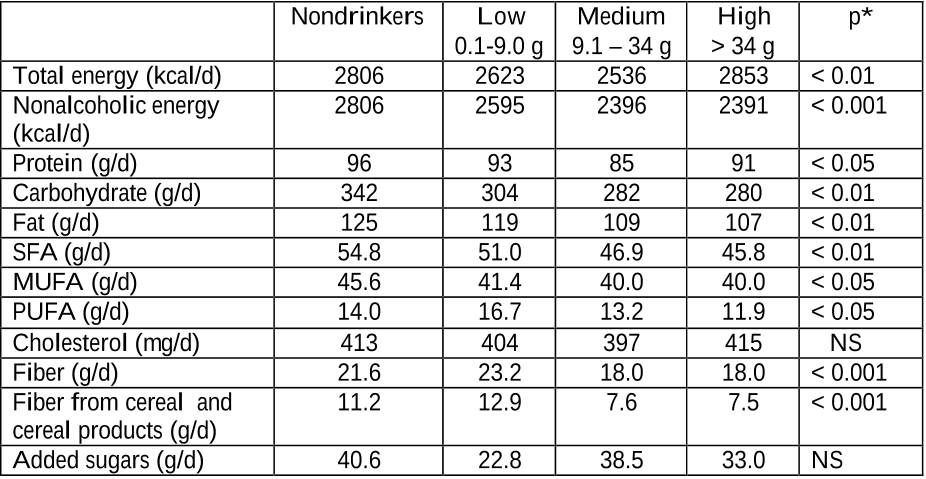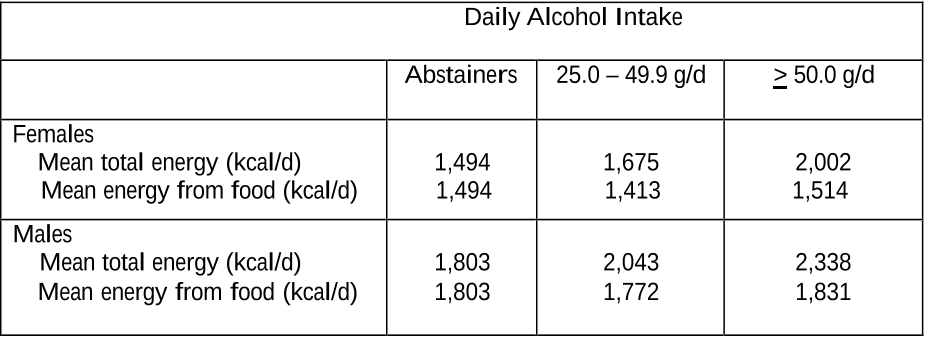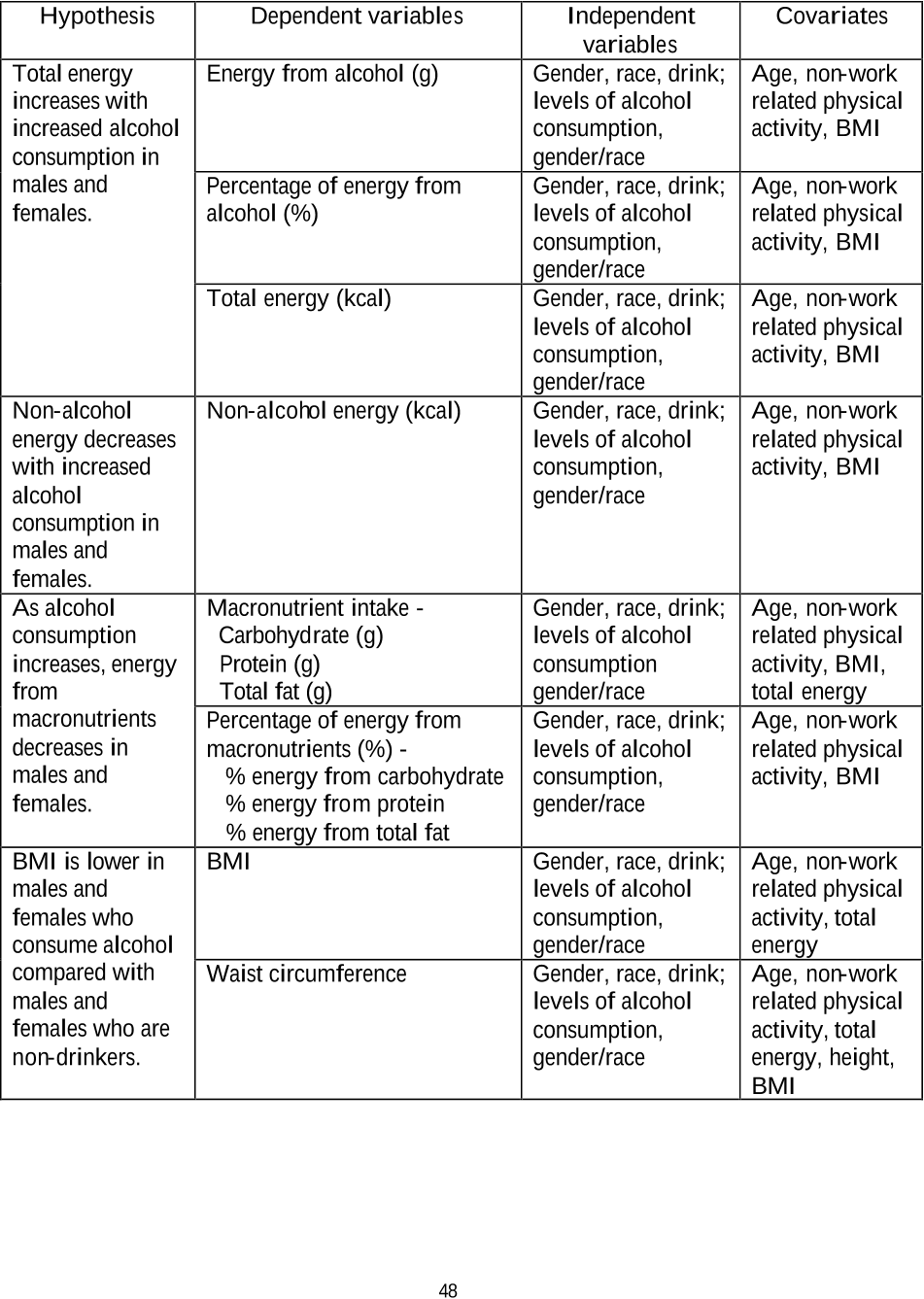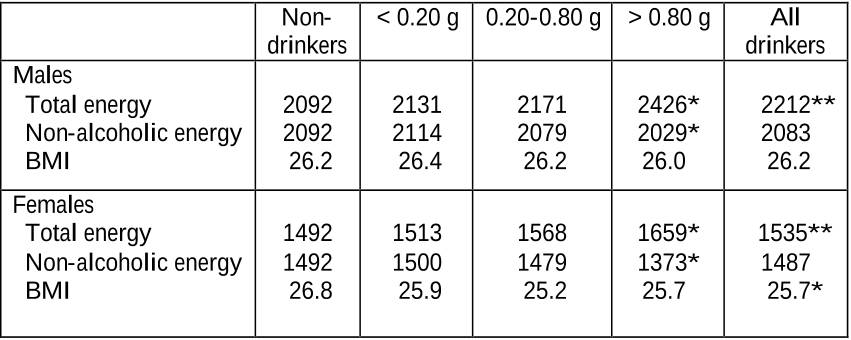The Relationship Among Alcohol Consumption, Dietary Intake, and Body Mass Index in Young Adults
About: This article is published in Journal of The American Dietetic Association.The article was published on 2005-08-01 and is currently open access. It has received 2 citations till now. The article focuses on the topics: Body mass index.
Summary (1 min read)
Jump to: [Introduction] – [Prevalence of Alcohol Consumption in Young Adults] – [Alcohol Metabolism] – [Overview] and [Body Mass Index]
Introduction
- She is an excellent mentor for whom my respect has grown tremendously over the past semesters.
- In 1995 to 1996, the Bogalusa Heart Study (BHS), an epidemiologic study of CVD risk factors from birth through young adulthood, surveyed young adults who were BHS participants in childhood to assess dietary intake and alcohol consumption.
- The YAQ is a semi-quantitative food frequency questionnaire in which foods are grouped into broad categories.
Prevalence of Alcohol Consumption in Young Adults
- The National Household Survey on Drug Abuse , a project of the Substance Abuse and Mental Health Services Administration of the federal government, was initiated in 1971 and is the primary source of information on the use of illicit drugs, alcohol, and tobacco (13).
- NHANES reports that the prevalence of overweight and obesity for adults was relatively constant from 1960 to 1980; however, by 1988-1994 NHANES III, overweight 12 and obesity increased significantly for white and black males and females aged 20 to 74 (45).
- They were shown to be valid and reproducible in both populations.
- Energy from alcohol was added to the diets of light drinkers but replaced non- alcohol energy, especially from carbohydrates, in moderate and heavy drinkers (15).
- A study of 179 middle-class males was designed to quantify long-term alcohol intake and to investigate the relation of level of alcohol consumption with dietary intake (71).
Alcohol Metabolism
- The paradoxical inverse relation sometimes seen between alcohol consumption and body weight remains unexplained by nutritionists.
- When alcohol energy was added to non-alcohol energy, subjects failed to gain weight (78, 81).
- Alcohol may increase meal size through a combination of direct and indirect effects (95).
- Frequency of drinking was consistently lower for females than for males.
- Possible effects of changes in marital status, employment status, and having children on alcohol consumption and the frequency of heavy drink ing was examined in 1,327 males and females aged 16 to 69 years (119).
Overview
- General data collection procedures used in the Bogalusa Heart Study (BHS) are described below; however, a specific data set was used for this thesis.
- The study design, participation, and protocols are described in detail elsewhere (39).
Body Mass Index
- The adjusted means (+ SE) for BMI (kg/m2) of drinkers by gender, race, and race/gender are shown in Table 11a.
- No other significant differences were seen among levels of alcohol consumption.
- Waist Circumference Table 12a shows the adjusted means (+ SE) for waist circumference (cm) of drinkers by gender, race, and race/gender.
Did you find this useful? Give us your feedback
Figures (13)

Table 2 Mean daily intake of energy (kcal/d) and selected dietary components (g/d, mg/d) according to level of alcohol consumption for 164 males (70) 
Table 7c Frequencies and percentages of non-drinkers and drinkers by race and gender 
Table 8b Adjusted means (+ SE) for alcohol intake (g/d) and the 
Table 1 Adjusted mean energy intake (kcal/d) by level of alcohol intake, in females and males (66) 
Table 10c shows the adjusted means (+ SE) for non alcohol energy intake (kcal/d) 
Table 5 Relation of health-related behaviors at three levels of alcohol intake (71) 
Table 6 Hypothesis, dependent variables, independent variables, and covariates used in the univariate ANOVA 
Table 11b Adjusted means (+ SE) for BMI (kg/m2) for non-drinkers and drinkers 
Table 14a Adjusted means (+ SE) for protein (g) and percentages (%) of total energy from protein for drinkers by gender, race, and race/gender 
Table 4 Mean total energy intake and energy sources at three levels of alcohol consumption (71) 
Table 3 Age-standardized daily energy intakes and BMIs for males and females by alcohol consumption (15) 
Table 15a Adjusted means (+ SE) for total fat (g) and percentages (%) of 
Figure 1. Past alcohol use by age: 2001 (Source: NHSDA).
Citations
More filters
01 Jan 1983
TL;DR: Intake of spirits and beer as well as smoking was measured by questionnaire in a random population sample from two counties of Eastern Finland in 1972 and during a 7-yr follow-up 209 of these men had developed an acute myocardial infarction and 223 men had died.
Abstract: Intake of spirits and beer as well as smoking was measured by questionnaire in a random population sample from two counties of Eastern Finland in 1972. At the same time serum cholesterol, triglycerides and blood pressure were measured in a field examination. The study material consists of 4063 men aged 30-59 years (participation rate 92%). During a 7-yr follow-up 209 of these men had developed an acute myocardial infarction (AMI) and 223 men had died. Reported spirits and beer intake had both a strong positive association with smoking and serum triglycerides, a weak positive association with diastolic blood pressure, but no relationship to serum total cholesterol. Use of spirits at least once a week was associated with a reduced risk of AMI. The relative risk (RR), adjusted for age and conventional coronary risk factors was 0.5 (95% confidence interval (CI), 0.3-0.9). Consumption of beer had no significant relationship to the risk of AMI. Consumption of at least five bottles of beer a week was related to a slightly excessive risk of death from any cause (adjusted RR = 1.5, 95% CI = 1.0-2.1). Spirits intake had no significant association with the risk of death.
84 citations
01 Jan 1987
TL;DR: For example, this article found that women who consumed alcohol 7-13 times per week had the greatest reduction in weight, while men had only a slight effect on weight in either survey.
Abstract: Alcohol contributes more than 10 per cent of the total caloric intake of adult drinkers in the United States. However, the effect of alcohol on body weight has not been adequately studied in the general population. The association between weight and frequency of alcohol consumption was examined in two national cross-sectional surveys: the Second National Health and Nutrition Examination Survey (HANESII; n = 10,929) and the Behavioral Risk Factor Surveys (BRFS; n = 18,388). Linear multiple regression was used to estimate the independent effect of alcohol on weight, adjusting for smoking, age, diet practices, physical activity, race, education, and height. Among men, alcohol had only a slight effect on weight in either survey. However, among women, alcohol was associated with a substantial reduction in weight, which was as large as the effect of smoking. Compared with nondrinkers, women who consumed alcohol 7-13 times per week had the greatest reduction in weight: -3.6 kg (95% confidence limits [CL] = -5.6,...
6 citations
References
More filters
TL;DR: The relationship of alcohol use to diet was examined in 2272 male and 2337 female adults aged 45 y and older who provided a quantitative diet history during 1977-1979 and drinkers were found to be less obese than abstainers.
33 citations
Journal Article•
33 citations
TL;DR: It is indicated that alcoholic beverages, and wine in particular, may enhance total EI at a meal relative to a soft drink, when served with no restriction.
Abstract: BACKGROUND: Alcoholic beverage drinking may increase total energy intake at a meal by various mechanisms and this effect may depend on the sort of beverage. OBJECTIVE: To test the effect of wine, beer and a soft drink served with a normal meal on food and total energy intake in non-obese men. DESIGN: A supper meal consisting of three consecutive dishes was presented to 22 young men. Ad libitum energy intakes (EI) of the meal were measured at three different occasions in a cross-over design with red wine, lager beer or a carbonated soft drink. This was done in two studies with different design. In the first study the beverages were supplied ad libitum and in a second study the intake of the beverages was fixed: beer and soft drink at 9 ml/kg body weight and wine isoalcoholic to beer, 3.185 ml/kg body weight. RESULTS: In the ad libitum beverage study total EI was higher with wine than with the soft drink and beer (P<0.05). In the fixed beverage study differences in total EI did not reach statistical significance (P=0.14), although the intake of goulash was higher with wine and beer than with the soft drink (P<0.005). CONCLUSION: These data indicate that alcoholic beverages, and wine in particular, may enhance total EI at a meal relative to a soft drink, when served with no restriction.
31 citations
TL;DR: The results support recent speculation that alcohol consumption may not be as "fattening" as traditionally believed and partially offset the large calorie surplus seen at higher levels of consumption.
Abstract: The relation of alcohol use to calorie intake and adiposity was studied in 155 non-smoking, overweight men Alcohol use and calorie intake were assessed by 7-day dietary record, and body composition was determined by hydrostatic weighing Increased intake of food calories (ie, non-ethanol calories only) on alcohol-drinking days was compensated for by decreased food consumption on non-drinking days of the week Added alcohol calories were not offset during the week and resulted in a surplus intake of over 4,000 kcal/wk for men in the highest drinking group Although alcohol calories were “added” to food intake, alcohol use was unrelated to level of adiposity This finding was not accounted for by concomitant differences in exercise status Basal metabolic rate, however, was elevated in men imbibing one or more “drinks” per day (as compared to abstainers and light-drinkers) Increased basal energy expenditure may have partially offset the alcohol calories of men at lower levels of alcohol intake, but it d
30 citations
29 citations